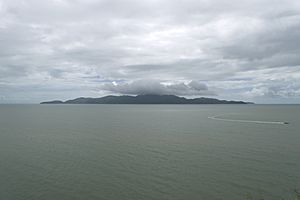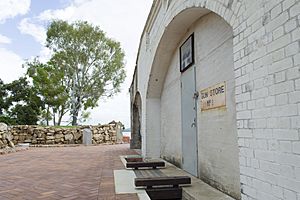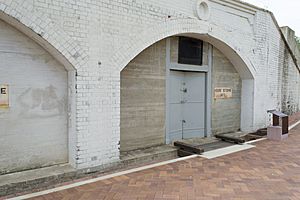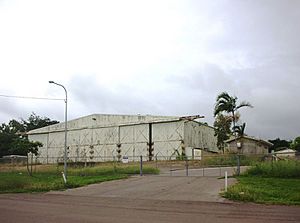Kissing Point Fortification facts for kids
Quick facts for kids Kissing Point Fortification |
|
|---|---|

Kissing Point Fortification, 2007
|
|
| Location | 38-40 Howitt Street, North Ward, City of Townsville, Queensland, Australia |
| Design period | 1870s - 1890s (late 19th century) |
| Built | 1891 & 1939–1941 |
| Architect | Peter Scratchley, Edward Druitt |
| Official name: Kissing Point Fortification & Jezzine Barracks (part) | |
| Type | state heritage (built) |
| Designated | 5 February 2010 |
| Reference no. | 601129 |
| Significant period | 1880s - 2007 |
| Significant components | wall/s - retaining, vista/s, parade ground/quadrangle/assembly ground, mounting block/stand, views from, machine gun mounting, magazine / explosives store, guns/weaponry/armament, lookout/observation platform, tunnel - military, casemate/s, drill ground/parade ground, gun emplacement, views to, objects (movable) - defence, ventilation shaft - military, store/s / storeroom / storehouse |
| Builders | A McMillan (Govt Foreman of Works c1890) |
| Lua error in Module:Location_map at line 420: attempt to index field 'wikibase' (a nil value). | |
The Kissing Point Fortification is a historic military site in North Ward, Townsville, Queensland, Australia. It was designed by Peter Scratchley and Major Edward Druitt. Construction began in 1891 and continued from 1939 to 1941. It is also known as Jezzine Barracks. This important site was added to the Queensland Heritage Register on 5 February 2010.
Today, it is home to the Army Museum of North Queensland.
Contents
History of Kissing Point Fort
The Kissing Point Fortification is on a rocky headland. This headland separates Cleveland Bay and Rowes Bay in Townsville. The fort was built in 1891. It was part of a plan to protect Queensland's ports from attacks by ships.
Before the 1860s, Britain protected its colonies in Australia. But in 1862, Britain asked the colonies to pay for their own defense. So, British soldiers slowly left Australia. The last ones left in 1870.
By the 1870s, Australia was growing fast. People worried about attacks from countries like Russia and France. In 1876, the Australian colonies asked two British Royal Engineers, Colonel Sir William Francis Drummond Jervois and Lieutenant-Colonel Peter Scratchley, for advice. They were experts in building forts to protect coastlines.
Jervois and Scratchley visited Queensland in 1877. They said the biggest threats were attacks by ships. They suggested building forts along the coast. Brisbane, as the capital, was the first to get a fort at Fort Lytton in 1880.
Townsville became a port in 1865. Gold discoveries nearby, like at Charters Towers, made Townsville grow. The Great Northern Railway connected these goldfields to Townsville's busy port. This made Townsville very important for northern Queensland.
In 1881, Lieutenant-Colonel George Glendower Blaxland chose Kissing Point for a battery. A battery is a place where guns are set up. In 1882, Scratchley suggested putting two large guns at Kissing Point. He also recommended building a small magazine (where ammunition is stored).
The Queensland Defence Act of 1884 changed how defense was organized. It created a small permanent army and a part-time militia. In 1885, the Townsville Garrison Battery was formed. By June 1885, the guns Scratchley suggested were set up at Kissing Point. They were even fired!
The land for the battery was officially set aside for defense in 1886. The Kennedy Regiment, a local army unit, was also formed in Townsville that year.
Training and Fort Construction
From 1887, soldiers practiced drills at Kissing Point. As more volunteer units formed, they needed bigger training areas. In 1889, training moved to Norman Park, next to Kissing Point. This area was used for annual army camps until World War II.
By the late 1880s, defense ideas and weapon technology were changing. Major Edward Druitt was hired to design the new fort at Kissing Point. He arrived in 1890 and quickly made a plan.
The fort included a raised wall facing the sea, two gun positions, and an underground magazine. Tunnels connected the magazine to the guns. There was also a lookout, a storage room (casemate), and places for range finders. Behind these, there was a sunken path and a small parade ground.
The Kissing Point battery was mostly finished by June 1891. It cost about £3500. Druitt then moved to Thursday Island to work on Green Hill Fort. The two large 6-inch guns were installed at Kissing Point by October 1892.
Buildings for the soldiers were put up near the fort. These included officer's quarters, barracks, a kitchen, and stables. These buildings were removed by the late 1960s.
In 1900, some changes were made to the fort. Air vents were added to the casemate store. In 1905, a new Battery Commander's Post was installed. In 1936, the original 6-inch guns were replaced with newer 4.7-inch guns. One of the original 6-inch guns was thrown over the cliffs. It was found in 1970 and put back in one of the gun positions.
After Australia became a federation in 1901, defense became a national responsibility. In 1909, Field Marshall Lord Kitchener visited the fort. He said the guns were old-fashioned and not worth keeping.
World War II and Beyond
The Kennedy Regiment continued to train at Kissing Point. When World War II started in September 1939, soldiers used the Kissing Point Barracks for training. In 1940, new 4.7-inch guns were installed.
In 1941, the area was renamed Jezzine Barracks. This was after a town in Lebanon where the 31st Battalion fought a battle. Townsville became a major supply center for Australian and US troops during the war.
By 1943, the threat of Japanese attack had lessened. The 4.7-inch guns were moved to Cape Pallarenda. After World War II, Jezzine Barracks was used for various army units. It became a training depot for national service groups from 1955.
In the 1960s, many older buildings were torn down. Parts of the 1891 gun positions and magazine were destroyed and filled in. The casemate was kept as a store. Later, in 1979, a team from the Army Museum of North Queensland began restoring the fortification. They uncovered what had been buried and repaired damaged areas. The Museum opened in the Casemate Store Rooms in 1980.
In 1997, the Australian Government considered selling Jezzine Barracks. But the local community strongly wanted the site to be kept for public use. In 2006, parts of the site were given to the Townsville City Council. The Australian Government kept ownership of the headquarters building and Jezzine House.
Description of the Fort
The military site in Townsville includes the Kissing Point fortification and Jezzine Barracks. The fort is on a rocky outcrop in the north-east corner. The barracks spread out to the west and south.
From the fort, you can see amazing views. You can see Pallarenda Beach and Cape Pallarenda to the north-west. You can also see The Strand beach and Townsville harbour. In the distance, you can see Magnetic Island and Mount Elliot. These views were important for defending the coast.
Kissing Point Fortifications
The Kissing Point fortification has two gun positions, an underground magazine, and a casemate store. It also has a machine gun position, a lookout, and two range finder spots. These are all along a sunken pathway. This path has a raised wall on one side and a low stone wall on the other. It opens up to a small parade ground.
Casemate or Underground Store Rooms
This building is built into the ground. It has concrete walls and roof. The front is made of red brick. Inside are three arched underground rooms. These rooms were used for storage and as a telephone room. They have been restored and painted.
Lookout
This is a narrow passage and stairs built into the ground. It leads to a sheltered lookout point. From here, soldiers could watch the sea.
Magazine
This brick and concrete building is mostly underground. It has rooms, corridors, and trenches. It was used to safely store ammunition and move it to the guns. It has a brick front with arched doorways and windows. Inside, there are small rooms and a narrow corridor. This structure was partly destroyed in the 1960s but has been largely restored.
Gun Emplacements
These are circular platforms where the guns were placed. They have concrete walls around them. In the middle of each platform is a concrete stand for the guns. One gun is a 6-inch Armstrong Coastal Defence Gun. It was found after being thrown over the cliffs. The other 6-inch gun came from Magazine Island Fort.
Depression Range Finder (DRF) Positions
These were places where special tools called DRFs were mounted. These tools helped soldiers figure out how far away enemy ships were. They are small, square trenches with a concrete stand in the middle.
Manning Parade Ground
This is a flat, open area. It is surrounded by the low stone wall that protects the fort on the land side. Soldiers would gather here.
Machine Gun Position
This is a small, curved area protected by the low retaining wall. It was a spot for a machine gun.
Memorials
There are several memorials at the site. One is a flagstaff from the American War Cemetery. It has bronze plaques at its base. Another is a stone with a plaque remembering the 31st Battalion, Kennedy Regiment.
Jezzine Barracks
The Jezzine Barracks complex has several areas. To the south-west of the fort, there were small sheds and huts. Along Howitt Street, there were houses for married soldiers. Near the fort, there is Jezzine House and the 31 RQR headquarters building. The headquarters building has offices and a drill hall.
P1 Type Huts
Near the fort's entrance, there are five P1 type huts. These huts were built during World War II. They are rectangular, made of timber, and have gable roofs. They are raised off the ground on concrete stumps. These huts were designed to be built quickly and are important examples of wartime buildings.
Parade Ground
The parade ground is a flat, grassy area. It is used for drills and ceremonies. It is surrounded by roads and some trees.
Army Museum of North Queensland
The Army Museum of North Queensland is located in a renovated building at Jezzine Barracks. It tells the story of the Australian Army in North Queensland. You can see photos, weapons, uniforms, and more. There are displays about different wars, from the Colonial era to modern times.
Why Kissing Point is Important
Kissing Point Fortification and part of Jezzine Barracks are listed on the Queensland Heritage Register. This means they are important to Queensland's history.
The fort shows how Queensland defended its coast in the late 1800s. It was part of a system of forts built along Australia's east coast. This highlights Townsville's role as an important port.
The land around the fort was used for army training for over 125 years. The parade ground still shows this long history. The five P1 huts from World War II are also important. They show how Australia quickly built up its defenses during the war.
The fort can still teach us about how these military sites were designed and built. It helps us understand Australia's defense history.
The Kissing Point fortification is a great example of a 19th-century coastal battery. It shows how Queensland protected itself before airplanes were used in war. It still has its original parts: gun positions, magazine, range finder spots, lookout, and store rooms. All these parts work together to show its defensive purpose.
Major Edward Druitt and Lieutenant-Colonel PH Scratchley were key figures in designing these defenses. They helped Queensland protect itself when British soldiers left.
Kissing Point is also beautiful. It is part of a stunning coastal landscape. The wide views from the fort are valued by many visitors. It is also a landmark for people looking at Townsville from the bay.
The fort and barracks are very important to the people of Townsville. They represent security and pride. People showed how much they cared when they campaigned to keep the site for public use.
Finally, the site has a special connection to the Kennedy Regiment. This is one of Queensland's oldest military units. It was based at Jezzine Barracks for many years. Soldiers from this regiment fought in both World Wars and earned many honors.
Images for kids






